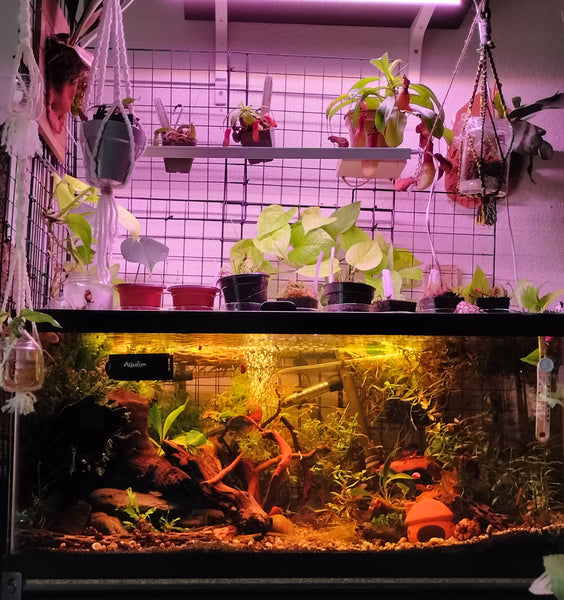Best Plants and Fish for Low Light Tanks

A low-light fish tank isn’t that too difficult to set up, but it does require some specific considerations.
After all, trying to grow lush plants under dim conditions takes a little research. But having a low-light tank has its perks.
Besides being energy-efficient, low-light tanks have fewer algae issues and can be incredibly beautiful.
In this post, I'll share my top picks for low-light aquarium plants and fish, plus some tips on creating a thriving ecosystem in these subdued environments.
Best Plants for Low-Light Aquariums
Finding the right plants for a low-light aquarium can make all the difference. These plants thrive with minimal light, growing slowly and adapting well to various conditions.

Low-Light Plant Characteristics
- Slow Growth: Low-light plants typically grow slower, meaning less frequent pruning.
- Adaptable: They can adjust to a range of water conditions, making them perfect for beginners.
Popular Low-Light Plant Options
- Java Fern: This hardy plant attaches to rocks or driftwood, making it easy to position in your tank. It doesn't need much light and grows well in various water conditions.
- Anubias: Known for its thick, dark green leaves, Anubias is very low maintenance. It can be anchored to decorations or left to float.
- Cryptocoryne: Crypts are versatile and come in many varieties. They are slow-growing and can handle low light levels, though they may take time to establish.

Planting and Care Tips
- Placement: Position plants where they can get some indirect light, avoiding deep shadows.
- Substrate: Use nutrient-rich substrate or add root tabs to provide essential nutrients.
- Water Quality: Maintain good water quality with regular changes and proper filtration.
- Fertilization: Use liquid fertilizers sparingly to boost growth without overwhelming the plants.
Also, when planting Java Fern or Anubias, don't bury the rhizome. Tie them to hardscape instead. As for crypts, plant them directly in the substrate. They might "melt" at first, but don't panic! It's normal, and they'll bounce back.
And don’t forget to trim your plants occasionally to encourage bushier growth.
Choosing the Right Fish
There are fish who love to be in a low-light setting. Getting them to bat for your team is necessary for a successful low-light tank.
Fish for low-light conditions
Low-light tanks are perfect for peaceful, adaptable fish. These little guys don't need bright lights to thrive. They're often more relaxed in dimmer conditions, or outright agoraphobic, which means less stress for them and you.
Some awesome low-light fish:
- Guppies: These colorful little swimmers are tough as nails. They're active and fun to watch, even in low light.
- Neon Tetras: Their bright stripes pop in dimmer tanks. You’ll love seeing them school together.
- Corydoras: These bottom dwellers are like tiny tank janitors. They're always busy and super cute.

Compatibility and Tank Size
Mix and match carefully. Guppies and tetras get along great. Corydoras are perfect tankmates for both. For tank size, think about your fish's adult size. A 20-gallon tank works well for a small group of species.
Don't overstock! I recommend starting with 5-6 1-inch fish of each species in a 20-gallon tank. It's better to have fewer, happier fish than a crowded tank.
Watch for signs of stress or aggression. If you see any, it might be time to rethink your combination.
Remember, a happy fish is generally an active fish. Even in low light, your fish should be swimming around and exploring. If they're not, it might be time to adjust your setup.
Creating a Balanced Ecosystem
A thriving low-light aquarium is all about balance.
Since we specialize in natural freshwater, community aquariums, our recommendations will reflect that.
The key elements that'll keep your setup are the following:
Substrate and filtration
Substrate matters big time in low-light tanks. Use a nutrient-rich substrate to give your plants a boost.
For filtration, sponge filters are more than adequate. They're gentle enough for delicate plants and provide a great home for beneficial bacteria.
Brief Overview of Water Parameters
- Temperature: Most low-light fish like it between 72 and 78°F.
- pH: Aim for 6.5-7.5. Test weekly and adjust slowly if needed.
- Hardness: Soft to medium water works best. If your tap water is on the hard side, mix in some RO (reverse osmosis) water, or add a buffer like Catappa leaves or driftwood that will break down over time.
Maintaining Water Quality in Low-Light Aquarium
- Regular water changes: Do 20-30% every week, as a rule of thumb.
- Don't overfeed: Excess food leads to poor water quality. Feed your fish small amounts twice a day.
- Add some floating plants if you need more shade. If you're already operating with a low powered LED light, then maybe avoid them.
- Keep an eye on algae: A little is okay, but if it's taking over, cut back on feeding. Maybe you don't have a low-light aquarium after all!
- Test your water regularly: You can use test strips for quick checks and liquid tests for accuracy.
Low-light tank doesn't necessarily mean low maintenance. But with these tips, you'll be well on your way to a balanced, beautiful aquarium.
Takeaway
Creating a thriving low-light aquarium is all about choosing the right plants and fish and maintaining a balanced ecosystem.
With slow-growing plants like Java Fern and peaceful fish like guppies, plus careful attention to water quality, you can create a stunning underwater world that's easy on the eyes and the electric bill.
SUBSCRIBE FOR SALES,STOCK ANNOUNCEMENTS AND LATEST BLOG... DIRECTLY TO YOUR EMAIL!
- Choosing a selection results in a full page refresh.
- Press the space key then arrow keys to make a selection.
